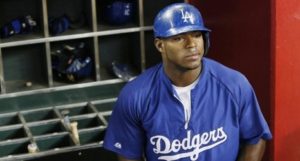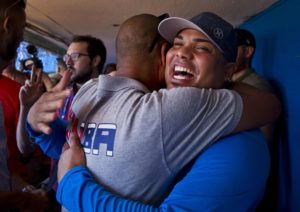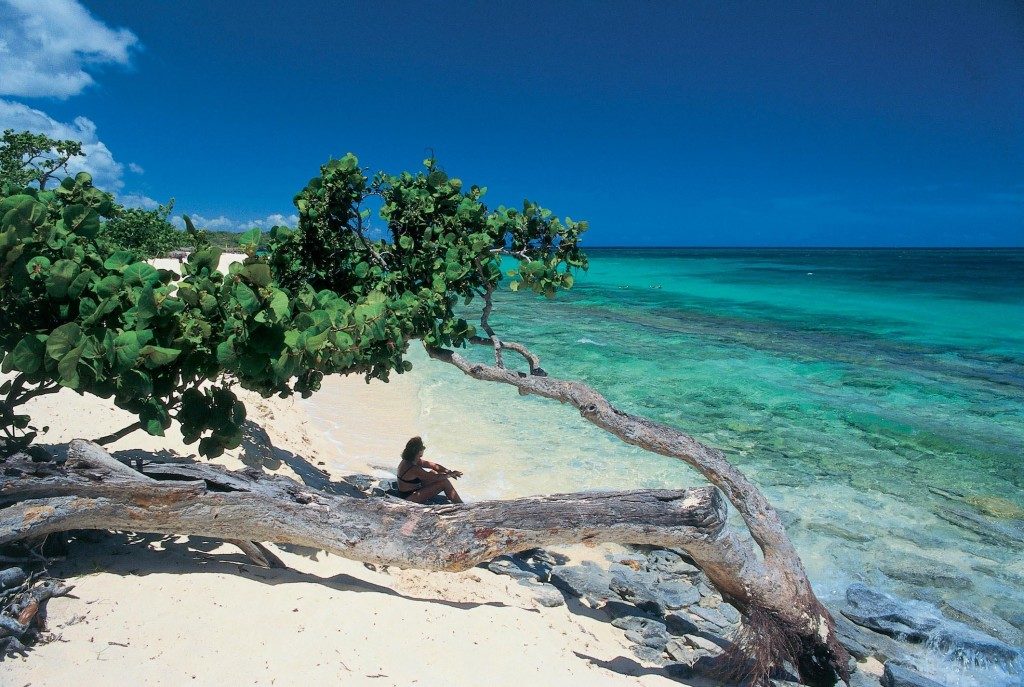CUBA: ISLAND OF BASEBALL (VIDEO). STORY OF CUBAN BALLPLAYERS IN THE UNITED STATES MAJOR LEAGUES.
Cuba: island of baseball, MLB Network documentary on Cuban baseball players in the major leagues, Premiering Tuesday night, according to USA TODAY Sports.
Danny Field, Alfonso Pozzo and Jed Tuminaro have made this audiovisual that tells the story of the Cuban players in United States since Luis Tiant and Tony Oliva, who joined the major leagues until Fidel Castro banned the professionalism in the sport in 1961, to modern “deserters” as Aroldis Chapman and José Abreu.
The drip of Cuban baseball players coming to the major leagues has become a torrent this past season: have reached an all-time high of 30 players.
“The people in this country have some idea of Cuba, and really do not understand very much the history of what so many of these guys have gone”, said Danny Field, one of the filmmakers.
“So I wanted to tell some of these stories of what it means to be a Cuban player in the major leagues…” The stories repeat themselves, and you see it when Luis Tiant speaks of Yoan Moncada. And there half a century between them,”added Field.
Narrated by the Cuban Bobby Cannavale, the documentary keeps a distance from political issues and focuses on the human stories: Abreu longs to reunite with his son. Jon Jay are you searching the former home of his grandparents in Matanzas; Tiant doubt return to the island in the middle of the concern for how it will be received.
The documentary shows how difficult is life off the field in the new country, because within the field goals have been less challenging.
The filming began during the tour of goodwill of MLB (Major League Baseball) by Cuba in December 2015, which marked the first return trip to their country of origin for Abreu, Yasiel Puig, Alexei Ramírez and Brayan Pena.
Jay, a gardener who signed two weeks ago with the Chicago Cubs, is also part of the trip to his ancestral homeland party. Born and raised in Miami, but Cuban parents, Jay did time in a busy schedule of children’s clinics and public appearances to locate the neighborhood of his grandparents in Matanzas and then spent two hours asking until you find where they lived.
“Walking these streets, I feel at home. I feel that I belong to here. Here you could definitely have grown. Here is where my family comes from,”says Jay in the documentary.
Three months after the trip in December 2015, MLB returned to Cuba to document the visit of the first U.S. President in decades. The importance of the occasion is captured in scenes at the Latinoamericano Stadium, where Barack Obama and Raúl Castro sit side by side for a friendly match between the Tampa Bay Rays and the Cuban national team.
In the documentary, there is a devastating scene: Tiant, after the match, is congratulated by Obama and has to shake hands with Raúl Castro located next to the US President.
In the film, Tiant says the uncomfortable position of exchanging greetings with one of the men responsible for his exile and the hundreds of thousands of his countrymen: “what are you doing? Are you going to remove the hand? Are you going to turn your back? All the world would see that. For me, that’s a lack of respect. It doesn’t matter if you like it or not”.
Cuba: Island of baseball also honors pioneers players who initially left everything to try his fortune in the major leagues, including Barbaro Garbey and Rene Arocha.
Garbey came to the United States as a “marielito” in 1980. He signed with the Detroit Tigers and played three years in the major leagues, including winning the 1984 World Series season.
Arocha was the first member of the Cuban national team who stayed in Miami during a stopover in 1991 seeking asylum. The biggest career lasted only three more seasons, but Arocha is attributed the opening of the door to the wave of talented Cuban Baseball that would follow, while Garbey preceded it.
“Coming of a regime Communist that fostered the paranoia among their citizens, them players Cuban tend to be booked on their ‘ defections ‘.” “Only one of those interviewed, Brayan Peña, offered details on how escaped”, said one of the producers.
Them players Cuban of both sides of the narrow of the Florida crave the day in that can go and come freely between his country home and them United States, concerns USES TODAY Sports.
Penalty, that has been citizen American for several years but maintains links narrow with the island, is between which are observing closely all them changes political.
“I have the hope of that the Government of the President Trump know that my people need help”, said penalty to USED TODAY Sports.
“The people of Cuba are suffering, and I hope that President Trump do you need to improve the democracy of the Cuban people. “But not know how going to act, so have to wait and see what comes”, concluded.
Agencies/MLBSPorts/Network/Internet Photos/YouTube/Arnoldo Varona/TheCubanHistory.com
THE CUBAN HISTORY, HOLLYWOOD.
FOLLOW US ON TWITTER AND FACEBOOK. THECUBANHISTORY.COM
CUBA: ISLA DE BÉISBOL (VIDEO). HISTORIA DE JUGADORES CUBANOS EN LAS GRANDES LIGAS NORTEAMERICANA.
Cuba: Isla de Béisbol, un documental de MLB Network sobre los peloteros cubanos de las Grandes Ligas, se estrenará este martes por la noche, según informa USA TODAY Sports.
Danny Field, Alfonso Pozzo y Jed Tuminaro han realizado este audiovisual que relata la historia de los jugadores cubanos en Estados Unidos desde Luis Tiant y Tony Oliva, que se unieron a las Grandes Ligas antes de que Fidel Castro prohibiera el profesionalismo en el deporte en 1961, hasta los “desertores” modernos como Aroldis Chapman y José Abreu.
El goteo de los jugadores cubanos de béisbol que llegan a las Grandes Ligas se ha convertido en un torrente esta pasada temporada: han llegado a un máximo histórico de 30 jugadores.
“La gente en este país tiene una idea de Cuba, y realmente no entienden mucho la historia de lo que tantos de estos chicos han pasado”, dijo Danny Field, uno de los realizadores.
“Así que queríamos contar algunas de estas historias de lo que significa ser un jugador cubano en las Grandes Ligas… Las historias se repiten, y lo ves cuando Luis Tiant habla de Yoan Moncada. Y hay medio siglo entre ellos”, añadió Field.
Narrado por el cubano Bobby Cannavale, el documental mantiene una distancia de los temas políticos y se centra en las historias humanas: Abreu anhela reunirse con su hijo; Jon Jay busca la antigua casa de sus abuelos en Matanzas; Tiant duda de regresar a la Isla en medio de la preocupación por cómo será recibido.
El documental muestra cuán difícil es la vida fuera del campo en el nuevo país, porque dentro del terreno las metas han sido menos desafiantes.
La filmación se inició durante la gira de buena voluntad de MLB (Major League Baseball) por Cuba en diciembre de 2015, que marcó el primer viaje de vuelta a su país de origen para Abreu, Yasiel Puig, Alexei Ramírez y Brayan Peña.
Jay, un jardinero que firmó hace dos semanas con los Cachorros de Chicago, también formó parte del partido de viaje a su patria ancestral. Nacido y criado en Miami, pero de padres cubanos, Jay hizo tiempo en una apretada agenda de clínicas infantiles y apariciones públicas para localizar el vecindario de sus abuelos en Matanzas y luego pasó dos horas preguntando hasta encontrar donde vivían.
“Caminando por estas calles, me siento en casa. Siento que pertenezco a aquí. Aquí definitivamente podría haber crecido. De aquí es de donde viene mi familia”, dice Jay en el documental.
Tres meses después del viaje de diciembre de 2015, la MLB regresó a Cuba para documentar la visita del primer presidente estadounidense en varias décadas. La importancia de la ocasión se capta en escenas en el Estadio Latinoamericano, donde Barack Obama y Raúl Castro se sientan uno al lado del otro para presenciar un partido amistoso entre los Rays de Tampa Bay y la selección nacional cubana.
En el documental, hay una escena devastadora: Tiant, después del partido, es felicitado por Obama y tiene que estrechar la mano de Raúl Castro que se encuentra al lado del presidente estadounidense.
En el filme, Tiant comenta la incómoda posición de intercambiar saludos con uno de los hombres responsables de su exilio y del de cientos de miles de sus compatriotas: “¿Qué vas a hacer? ¿Vas a quitarle la mano? ¿Vas a darle la espalda? Todos en el mundo verían eso. Para mí, eso es una falta de respeto. No importa si te gusta o no”.
Cuba: Isla de Béisbol también rinde homenaje a los jugadores pioneros que inicialmente dejaron todo para probar su fortuna en las Grandes Ligas, entre ellos Bárbaro Garbey y Rene Arocha.
Garbey llegó a los Estados Unidos como un “marielito” en 1980. Firmó con los Tigres de Detroit y jugó tres años en las Grandes Ligas, incluyendo la temporada ganadora de la Serie Mundial 1984.
Arocha fue el primer miembro de la Selección Nacional cubana que se quedó en Miami durante una escala en 1991 buscando asilo. Su carrera en las Mayores duró solo tres temporadas más, pero Arocha se atribuye la apertura de la puerta para la ola de talento beisbolero cubano que le seguiría, a pesar de que Garbey le precedió.
“Viniendo de un régimen comunista que fomentaba la paranoia entre sus ciudadanos, los jugadores cubanos suelen ser reservados sobre sus ‘deserciones’. Solo uno de los entrevistados, Brayan Peña, ofreció detalles sobre cómo escapó”, dijo uno de los productores.
Los jugadores cubanos de ambos lados del estrecho de la Florida anhelan el día en que puedan ir y venir libremente entre su país natal y los Estados Unidos, refiere USA TODAY Sports.
Peña, que ha sido ciudadano estadounidense por varios años pero mantiene vínculos estrechos con la Isla, está entre los que están observando de cerca todos los cambios políticos.
“Tengo la esperanza de que el Gobierno del presidente Trump sepa que mi pueblo necesita ayuda”, dijo Peña a USA TODAY Sports.
“El pueblo de Cuba está sufriendo, y espero que el presidente Trump haga lo necesario para mejorar la democracia del pueblo cubano. Pero no sabemos cómo va a actuar, así que tenemos que esperar y ver lo que viene”, concluyó.
Agencies/MLBSPorts/Network/Internet Photos/YouTube/Arnoldo Varona/TheCubanHistory.com
THE CUBAN HISTORY, HOLLYWOOD.







